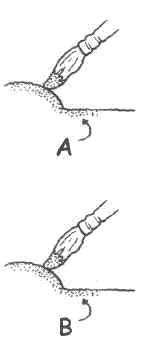Stop the Bleeding
- This page describes a technique to keep paints from bleeding and to highlight low relief features.
Back to: |
|||
Where two different colors meet, for example, arms
and sleeves, beard and chest, and so forth, make a knife cut at the dividing point.
This figure shows how this works.
provides a channel for the finish to flow into, thus distinguishing the two features. Relief carvers could use this technique to highlight low reliefs after the stain or finish is applied.
|

N O T E S
|
||
UPDATED: 03.08.2001 |
|||